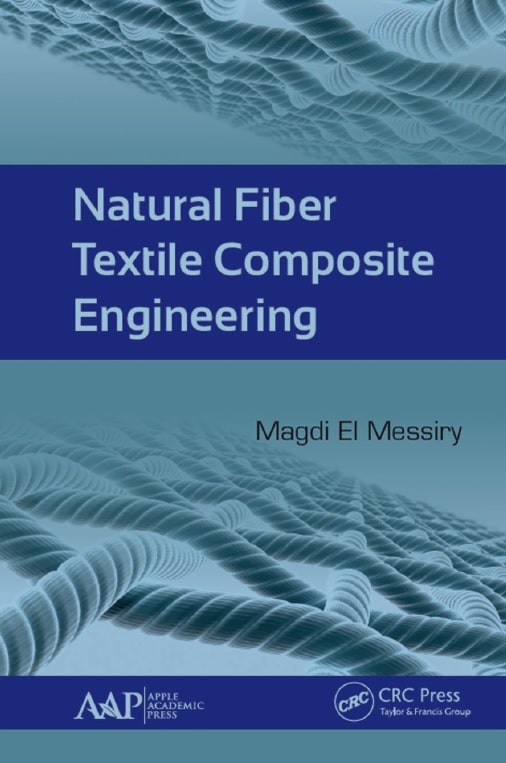
Contents:
List of Abbreviations ………………………………………………………………………. vii
Preface ………………………………………………………………………………………….. xi
About the Author …………………………………………………………………………… xiii
Acknowledgments …………………………………………………………………………….xv
Dedication …………………………………………………………………………………… xvii
Introduction ………………………………………………………………………………….. xix
PART I: APPLICATION OF NATURAL FIBER POLYMER
COMPOSITES ………………………………………………………………………………………. 1
1. Application of Textile Composites …………………………………………………… 3
2. Natural Fiber Properties ………………………………………………………………. 29
PART II: DESIGN OF NATURAL FIBER POLYMER
COMPOSITES …………………………………………………………………………………….. 77
3. Natural Fiber Reinforcement Design …………………………………………….. 79
4. Textile Reinforcement Modification and Matrix Materialization …….125
5. Some Aspects of Textile Composite Design …………………………………… 157
PART III: COMPOSITE MANUFACTURING TECHNIQUES
AND AGRICULTURE WASTE MANUFACTURING …………………………. 205
6. Natural Fiber Composites Manufacturing Techniques …………………. 207
7. Agriculture Waste Composites …………………………………………………….. 241
PART IV: COMPOSITE MATERIAL TESTING METHODS:
FIBER, YARN, FABRIC, POLYMER AND COMPOSITE ………………….. 281
8. Testing Methods for Composite Materials ……………………………………. 283
Index …………………………………………………………………………………………… 353
List of Abbreviations
AFD average fiber diameter
BOD biochemical oxygen demand
BOIM biological methods
BVI bulk volume irreducible
CAM computer-aided manufacturing
CM chemical method
CMC ceramic matrix composites
COD chemical oxygen demand
CPE chlorinated polyethylene
CPVC chlorinated polyvinyl chloride
CRE constant rate of extension
CRL constant rate of loading
CRT constant rate of traverse
CTE coefficient of thermal expansion
CV coefficient of variation
DCP dicumyl peroxide
DMA dynamic mechanical analysis
DO dissolved oxygen
DPF date palm tree fiber
EBM extrusion blow molding
EMO environmental management system
EPDM ethylene propylene di-monomer
EPS expanded polystyrene
ETFE ethyl tetra fluoro ethylene
EVA ethylene vinyl acetate
FDM fuse deposition modeling
FPC fiber–plastic composites
FRC fibers in concrete
GRP glass-reinforced polyester
HAPs hazardous air pollutants
HDF high density fiber
HDPE high density polyethylene
HIPS high impact polystyrene
LCA life cycle assessments
LCM liquid composite molding
LDPE low density polyethylene
LDPE polyethylene low density
MACT maximum achievable control technology
MAPP maleic-anhydride-modified polypropylene
MCC microcrystalline cellulose
MDF medium density fiberboard
MF melamine-formaldehyde
MFCs micro fibrillated celluloses
ML mean length
MMC metal matrix composites
MS margin of safety
NDT non-destructive testing
NFPC natural fiber composites
OFDA optical fiber diameter analyzer
PA polyamide
PB polybutylene
PBAT aromatic co-polyesters
PBS polybutylene succinate
PBSA aliphatic co-polyesters
PC polycarbonate
PCL poly-ε-caprolactones
PE polyethylene
PEA polyesteramides
PF phenol-formaldehyde
PGA polyglycolic acid
PHA polyhydroxyalkanoates
PHB poly-3-hydroxyalcanoates
PHB/HV poly(3-hydroxybutyrate-hydroxyvalerate)
PHBV poly(hydroxybutyrate-co-hydroxyvalerate)
PHCM physico-chemical methods
PHM physical methods
PLA polylactic acid
PMAA polymethacrylic acid
PMC polymer matrix composites
PMMA poly(methyl methacrylate)
PMPPIC polymethylene-polyphenyl-isocyanate
PP polypropylene
PS polystyrene
PTFE polytetrafluoroethylene
PU polyurethane
PVA poly(vinyl acetate)
PVB poly(vinyl butyral)
PVC poly(vinyl chloride)
PVF poly(vinyl fluoride)
PVOH poly(vinyl alcohol)
RF radio frequency
RFI resin film infusion
RIM resin injection molding
RS rice starch
RTM resin transfer molding
RVI resin vacuum infusion
SEM scanning electron microscope
SFOC synthetic fiber reinforcement
SLA stereolithography
SLS selective laser sintering
SMC compression molding
TDS total dissolved solids
TH total hardness
TSS total suspended solids
UF urea-formaldehyde
UHML upper half mean length
UI uniformity index
UP unsaturated polyester
UPVC unplasticized polyvinyl chloride
UR uniformity ratio
VARTM vacuum-assisted resin transfer molding
VIP vacuum infusion process
WCC wood cement composites
WF wood fiber
WPC wood-polymer composite
Preface
Natural fibers have a very long practice for textile materials manufacturing. Not only for garment and household textiles, but particularly these fibers are important for the manufacture of technical textiles. Immense attention has been given to the agricultural wastes of the crops that are primarly grown for the food industry. Their waste, such as the straw, contains fibers suitable to be used in the composite fabrication. Wood and forest residuals also enhance additional sustainable resources of materials that can be converted into composites. It was established by many investigators that the mechanical properties of natural fiber polymer composites may compete with traditional glass fibers in composites. Natural fibers, as a source of raw material, not only provide a renewable supply but could also produce economic development for the countryside areas.
The impact of agricultural waste on the environment currently encourages industrial units in agricultural areas to turn agricultural waste into several products that can be utilized in different market segments, such as the automotive, electronics, sports, civil engineering, transportation, marine, wind energy, and consumer goods. As a consequence, natural fiber composites have been experiencing a healthy growth in last five years, with an annual average rate of 10% (in EU it reached 30%). In North America the yearly consumption of natural fiber composite reaches about 1.5 kg/capita. The increase of the environmental concerns generates a demand and motivation for the implementation of natural fiber composites in various new applications.
This book sheds light on the area of natural fibers composites with updated knowledge of their application, the materials used, the methods of preparation, the different types of polymers, the selection of the raw material, the elements of design the natural fiber polymer composites for a particular end use, their manufacturing techniques, and finally life cycle assessments (LCA) of NFPC.
